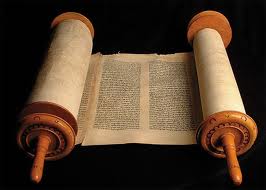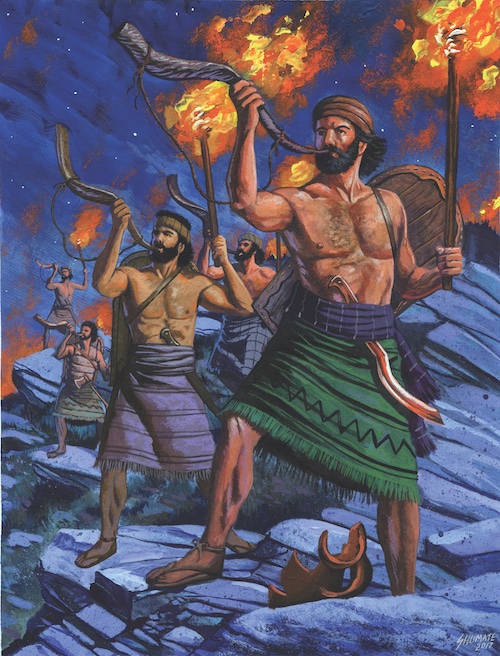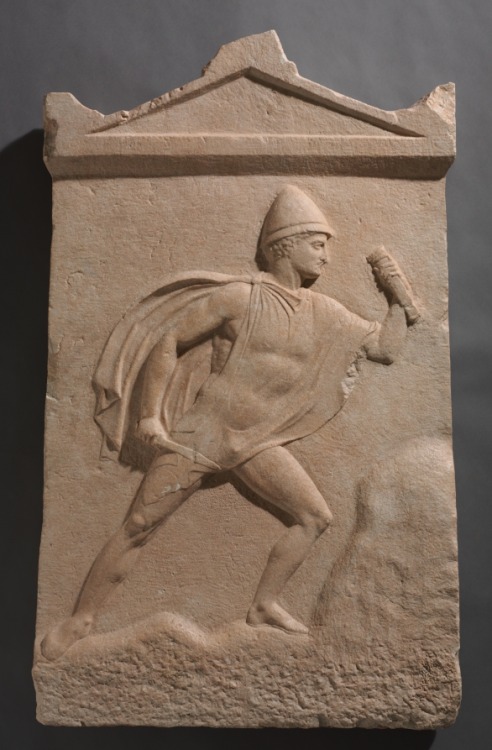Gideon’s 300 and the Sacred Band
In my last blog it looked like I had (finally) learned my lesson – when I submitted it, I got the congratulatory note from Jasper of ‘Proper blog length!’ But alas, I find that it was like grasping smoke – this one then ballooned out to nearly 8,000 words. All is not lost, however, and I have a cunning plan. Below is as close to a ‘proper blog length’ summary of those 8,000 words as I can make it, looking at a fascinating moment when Biblical history and the history of ancient Greek warfare may intersect. If you, dear reader, are inspired by what follows, I can certainly send you the full 8,000 words (which is complete with references)!
Gideon's army
In the Book of Judges (Sefer Shoftim 7:2-25), the seventh book in the Hebrew Bible, the tale of Gideon’s campaign against the Midianites is told. Gideon began with an army of 32,000 men but was instructed by the Lord to reduce that number. First, Gideon sent those who did not wish to fight home. This reduced his numbers by 10,000 men. Next, he took the remaining 22,000 men and reduced them further so that only 300 men remained. This number was acceptable, and Gideon was promised that with these 300 men he would conquer. He divided them into three companies of 100, led them on an attack on the Midianite camp, and won the victory. Now, to students of Greek military history the special selection of 300 men immediately reminds them of the 300s at Thermopylae and later 300s, especially the Theban Heiros Lochos, the Sacred Band. There are reasons why this second association should be more emphasized with regard to Gideon – Gideon led his troops on to victory after all (which might seem to preclude the association with Thermopylae). There are other aspects to the parallels, however. Gideon divided his 300 men into three companies of 100 men – this too seems to parallel practices in Greek armies (divisions of 100 men existed in both the Theban army and the Spartan hippeis). A parallel with Greek military institutions would, however, seem unlikely in a passage from the Old Testament, surely. The answer may surprise you. It is certainly not a parallel which has been noted. Now, I must admit that when I put this argument to a biblical scholar, he considered it unlikely, no more than a series of coincidences, but I remain undeterred.
 The Book of Judges
The Book of Judges
The date of the composition of the Book of Judges is complicated. It is considered the oldest work of Deuteronomistic History, the term coined by Martin Noth in 1943 to describe the author of the books of Joshua, Judges, Samuel and Kings who deliberately used the language of the earlier Book of Deuteronomy (the fifth book of the Hebrew Bible). Noth considered that the author of these books was a single individual who wrote in the mid-6th century BC, in exile. Some of this material was then later expanded and revised. At the same time, there is some material, such as the Song of Deborah (Judges 5:2-31), which is much older and was inserted into the books composed in the 6th century. In the 1960s, Frank Moore Cross argued that Judges was instead first written in the 7th century BC (again by a single author), since some aspects of the text appear to be pre-exilic, but with later revisions and updates. Another theory accepts Noth’s 6th century date but argues for additional redactions after the initial composition down into the 4th century BC. There are other theories which accept earlier and later dates for alterations. We therefore have, roughly, the material which existed before the Deuteronomistic History was compiled (pre-Deuteronomistic), the author’s contribution, and those alterations made later (post-Deuteronomistic). The last phase of these later alterations occurred in the late Persian and early Hellenistic period in the 4th century BC, and it is these (and contemporary Greek history) which are of interest for us here in regard to Gideon and his force of 300 men. I have recently explored how 300 was a remarkably common number for elite forces in Greek armies in the 5th and 4th centuries BC in a series of articles in Ancient Warfare (AW 14.2, 15.1 – one more is yet to come). The remarkable successes of these units of 300 coincides with the last period of post-Deuteronomistic additions to the Book of Judges and it is possible that the stories of their success (against great odds and expectation) were widely disseminated and influenced the author of one of these later additions.
 Image (right): Gideon leading his 300 men with torches and trumpets against the Midianites (Judges 7:19-21) by Johnny Shumate from Ancient Warfare XI.4.
Image (right): Gideon leading his 300 men with torches and trumpets against the Midianites (Judges 7:19-21) by Johnny Shumate from Ancient Warfare XI.4.
Gideon’s victorious battleplan, revealed to him in a dream, was to mount a night-time raid on the Midianite camp. This plan seems to raise the parallel of Diodorus of Sicily’s version of events at Thermopylae in 480 BC (11.10.1-4) which included a night-time raid on the Persian camp mounted by Leonidas’ men – this raid is missing from Herodotus’ account and our other sources. Diodorus may have used Ephorus as the source for this part of his Universal History and this may have a bearing on the influence on a late editor of the Book of Judges. Ephorus, from Cyme in Aeolis in Asia Minor (modern Nemrut Limani, Turkey), and in the Persian satrapy of Lydia, wrote his own, 29-book, Universal History before his death in 330 BC. This covered history from 480 BC down to 356 BC. In the 4th century BC, therefore, both Ephorus and the editor of Judges were Persian subjects, and we should keep in mind the possibility that Ephorus and his account of the exploits of elite groups of 300 hoplites may have been read in the Levant.
Parallels
Despite the parallel of the night-time raid on the Persian camp, the 300 at Thermopylae were eventually defeated by the Persians so the overall parallel with Gideon’s force and success seems to fall apart as a possible influence on the Judges passage. The exploits of later Greek 300s, however, provided the perfect parallel, especially the Sacred Band and the battle of Leuctra. The Theban Sacred Band was founded in the aftermath of the Thebans throwing off the yoke of Spartan dominance in 379/8 BC although it may have been the reestablishment of an elite unit of 300 men present in Theban and Boeotian armies in the 5th century BC. At the battles of Tegyra in 375 BC (Plutarch Pelopidas 16.2, 17.3-6, Diodorus 15.37.1-2), Leuctra in 371 (Diodorus 15.55-56; Plutarch Pelopidas 23) and Mantinea in 362 (Diodorus 15.82.1-88.3, Xenophon Hellenica 7.5.9-27), the Sacred Band stood in the front ranks of the Theban armies and led them to victory against the Spartans. The news (and shock) of these unexpected victories may have travelled quickly beyond the borders of Greece – we know that they may have influenced the writings of Plato (Symposium 178E-179A) and other states like Carthage instituted their own Sacred Bands in emulation of the Theban unit. The idea that such influence may have reached the Levant and the late editor of Judges should not be too surprising (especially, perhaps, through the writings of Ephorus if not before).
Organisation
Image (right): A Boeotian funerary stele dating to c. 390 BC and showing pilos helmet and cloak.
There are other parallels between Gideon’s force and Greek warfare too. The organisation of Gideon’s force into three companies of 100 (7:16) looks like Theban or Spartan organisation (Thucydides 7.19.3; Xenophon Constitution of the Lacedaemonians 4.3). We do not know if the Sacred Band had this organisation – we do have the unit and its commander, the lochagos, named but no smaller divisions are recorded. Other units within the Theban army may have been organised into 100s, however; Thucydides tells of three units of 100 Boeotian men sent to Syracuse. Spartan armies had a smallest unit of between 30 and 40 men, the enomotia – but the division into 100s seems to have been reserved for the hippeis. The organisation of armies in ancient Israel tended to centre around units of ten or fifty men, not the three hundreds of Gideon and certainly not a force as small as 300 men (armies are usually in the tens of thousands – often 10,000 (such as 2 Kings 13:7)). There is no other unit of 300 in the armies of ancient Israel although, perhaps, the 318 trained men born in the household of Abraham (Genesis 14:14) might be considered. It is unclear, however, if we should consider these a military unit as such.
The unwilling
There are other connections between Gideon’s force and the Theban formation at the battle of Leuctra in particular. Gideon’s force was reduced by those who did not want to be there. This parallels the accounts of the lead-up to the battle of Leuctra when Epaminondas may also have sent reluctant men away from the battle or placed them on the field in such a way that they would not be called upon to fight (Xenophon Hellenica 6.4.9, Pausanias (Periegesis 9.13.8). Diodorus (15.51.1-55.1) also has the weaker men excluded and Epaminondas fighting the battle with his chosen troops who were placed on one wing. Plutarch (Pelopidas 23.1-4) has the Sacred Band leading the charge, and the Thebans to victory. 
Image (right): The Lion of Chaeronea marks the mass burial of the Sacred Band at Chaeronea, where they were destroyed to a man by Alexander, son of Philip II of Macedon in 338 BC.
The text of the Judges passage does use the older, shorter form of שלש for “three” rather than the later שלוש spelling which might suggest genuine age to the passage. That said, short שלש does also occur (once) in the Book of Esther (9:15), in a passage written in the Persian period and dated to the reign of one of the Persian kings Xerxes I or Artaxerxes I, II or III; that is after 486 BC down to 338 BC – the same period we are arguing for a late emendation to Judges. It is entirely possible for a late editor to have deliberately used an earlier form of a word to give his work the veneer of age – it is, after all, a trait of the Deuteronomistic History in general. These parallels may be coincidences. In the combination of them, however, they seem to paint a picture of the influence of the remarkable accomplishments of near-contemporary Greek warfare on an account of how an elite and unlikely victory was achieved against great odds. Perhaps the best way for a late editor of the Book of Judges to frame such a story was provided by the unlikely victories of Greek 300s against similar odds, the stories of which were widely disseminated. Perhaps the work of Ephorus of Cyme (whose Universal History was written in a Persian satrapy) and which covered the period from 480 down to 356 BC (and therefore contained all the precedents we have mentioned) may have provided the editor of Judges with a combination of ideas. With all this in mind, it would seem most likely that it was the Sacred Band throwing off Spartan hegemony which provided the best parallels and inspiration for Gideon’s 300, and especially its actions at the battles of Tegyra and Leuctra.

